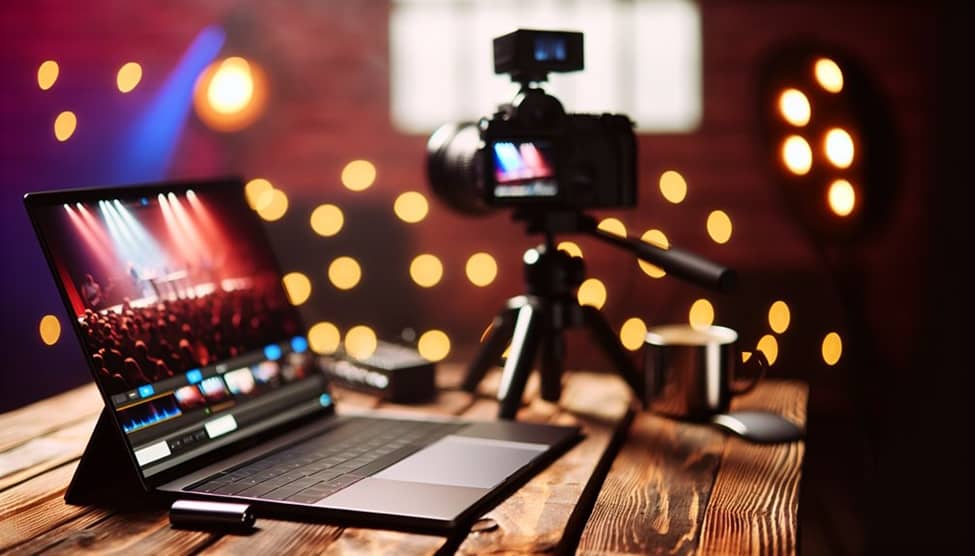Streaming live concerts from anywhere contrasts the thrill of a live audience with the technical challenges behind the scenes. You might wonder how to capture every note and emotion without being present at the venue. Start by choosing excellent cameras and audio interfaces, then consider the most suitable platform to reach your audience, like YouTube Live or Twitch. Don't forget to optimize your internet connection; a stable Ethernet setup can make all the difference. As you get the basics right, there's more to explore, like creating an interactive experience that keeps viewers engaged. What's next in this digital performance journey?
Essential Equipment Checklist
Setting up for a live concert stream requires a well-thought-out equipment checklist to guarantee seamless delivery.
Start with cameras selection; choose high-quality cameras that offer excellent resolution and low-light performance. Opt for multiple cameras to capture various angles, guaranteeing an engaging viewing experience.
Next, focus on audio interfaces. High-quality sound is essential, so pick reliable audio interfaces that can handle multiple inputs from instruments and microphones. Verify they're compatible with your streaming hardware and software.
Don't forget to test all connections and settings before the event. Properly configured, your equipment will capture the essence of the concert, delivering an immersive experience for viewers.
Choosing the Right Platform
Choosing the right platform to stream live concerts is like finding the perfect stage for your performance. You need a platform that highlights your music, guarantees smooth delivery, and maximizes audience engagement.
Start with a platform comparison: consider YouTube Live, Instagram Live, and Twitch. Each offers unique features—YouTube's broad reach, Instagram's interactive tools, and Twitch's dedicated community. Evaluate your audience's preferences to select the best fit.
Analyze technical specifications, such as resolution and latency, to guarantee your music sounds and looks its best. A platform should support your streaming goals, whether it's reaching a global audience or fostering a tight-knit fan base.
Optimizing Your Internet Connection
Once you've selected the ideal platform, ensuring a reliable internet connection becomes paramount for a successful live concert stream.
First, assess your bandwidth requirements. Check the platform's specifications—most recommend a minimum upload speed of 5 Mbps for HD streaming. Use online speed tests to verify your current speed matches or exceeds these needs.
Next, prioritize connection stability. Connect directly to your router using an Ethernet cable to reduce latency and packet loss. Wi-Fi can be unpredictable and may struggle with maintaining a stable connection, especially in crowded networks.
Finally, limit other devices' internet usage during the concert. This minimizes competition for bandwidth, ensuring your stream runs smoothly.
With these steps, your live concert experience can be seamless and uninterrupted.
Enhancing Audio and Visuals
To truly elevate your live concert streaming experience, focus on enhancing both audio and visuals.
Prioritize audio quality by using an external microphone. Built-in mics often capture ambient noise, reducing clarity. Choose a condenser mic for richer sound.
For visuals, a high-resolution camera is essential. Use at least 1080p to capture details and maintain sharpness.
Lighting dramatically impacts visual effects. Position lights at 45-degree angles to minimize shadows and highlight performers. Experiment with color gels to add mood.
Test your setup beforehand, adjusting settings for best performance. Stream during periods of low network traffic to reduce lag.
Tips for an Interactive Experience
Engaging your audience during a live concert stream requires strategic planning and execution. Start by incorporating real-time interaction to make your viewers feel part of the event. Use chat features to encourage comments and questions. Respond promptly, fostering a sense of community.
Implement polls or quizzes related to the concert, which can drive audience engagement and keep interest levels high. Include shout-outs or dedicate songs to viewers who interact the most, making the experience personal.
Integrate social media by encouraging viewers to share clips or photos with a specific hashtag, enhancing visibility. Employing interactive overlays that display live reactions or messages can also enrich the experience.
Ultimately, a successful interactive concert stream hinges on seamless integration of these elements to captivate your audience.
Conclusion
You've got the gear, the platform, and the connection—now it's showtime. By focusing on superior audio and visuals, you guarantee every note and image captivates your audience. Remember, interaction is key; engage with your audience like a maestro conducting an orchestra, making them feel part of the performance. With these strategies, you're not just streaming a concert; you're creating an unforgettable live experience that resonates across the globe. Ready, set, stream!








